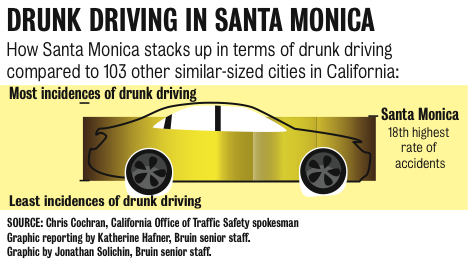Students driving or living in Santa Monica can now expect to encounter more driving-under-the-influence police checkpoints.
Drivers attempting to work their way from Third Street Promenade will likely be asked for their license by police as part of a new series of DUI checkpoints that will be established in Santa Monica starting in September.
In late August, the Santa Monica Police Department received a $43,200 grant from the California Office of Traffic Safety to implement bimonthly DUI checkpoints.
About once every two months, police will station themselves at select parts of certain roads and stop every car that passes, checking drivers’ licenses and looking for signs of intoxication.
Because those issuing the grant lack the manpower to keep track of the progress, they enlisted the UC Berkeley’s Safe Transportation Research and Education Center to regulate the implementation over the next year.
Santa Monica’s checkpoint plan is one of several projects across the state that the center will oversee by distributing the funds and ensuring they are used for their proper purpose, said Chris Cochran, a spokesman for the California Office of Traffic Safety.
Each year, several cities apply for traffic-related grants, and often include requests for funding of DUI checkpoints, Cochran said. Checkpoints are difficult for non-major cities to finance on their own, he added.
But only about 50 percent of applicants are given grants. Santa Monica was selected because of its clear problem with drunk driving, Cochran said.
Out of 103 similar-sized cities in California, Santa Monica has the 18th highest rate of accidents that result from drunk driving based on the area’s traffic congestion, Cochran said.
The city also has the seventh highest rate of drunk driving accidents when sorted by population, he added.
In the past year alone, there were about five serious or fatal instances of intoxication resulting in car accidents with vehicles, bikes and pedestrians ““ a number that is typical for the area but higher than that of surrounding areas, said Sgt. Richard Lewis, a spokesman for the Santa Monica Police.
The popularity of the areas’ bars and restaurants contributes to the steadily higher number of drunk driving instances, Lewis said.
The DUI checkpoints, funded by the grant for a year starting in September, are a proven deterrent of drunk driving, Lewis said. When the grant expires, police will apply for another one to continue the process.
By law, the police department must announce the checkpoints a week before they are constructed, although the locations of the checkpoints are not disclosed.
Traditionally, the locations are set up on major roads that lead to freeways during the evening rush hour, Lewis said.
There are smartphone apps available that track the exact location of these stops, Lewis said. But, the checkpoints are still successful at catching drivers off guard, he said.
Dalit Yadegaran, a third-year psychobiology student and a resident of Santa Monica, said she welcomes the increased police enforcement.
“It’s great that they’re doing this,” she said. “Santa Monica feels pretty safe but there are a lot of bars on Main Street. And sometimes people don’t want to pay for a cab, unfortunately.”
But she said she is wary that locations of the checkpoints might cause excessive traffic in the area if they are located on main roads like Wilshire Boulevard.
The first batch of DUI checkpoints funded by the grant have already been built on the streets, near main roads and freeway on-ramps, Lewis said. Officials plan to construct the next batch of checkpoints in November, he added.
